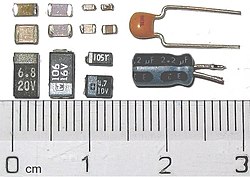
Back Kapasitor AF Kondensator (Elektrotechnik) ALS Condensador AN مكثف (كهرباء) Arabic كونداساتور ARY المكثف ARZ ধাৰক AS Condensador llétricu AST Kondensator (elektrik) AZ خازن AZB


A capacitor (also called condenser, which is the older term) is an electronic device that stores electric energy. It is similar to a battery, but can be smaller, lightweight and a capacitor charges or discharges much quicker. Capacitors are used in many electronic devices today, and can be made out of many different types of material. The Leyden jar was one of the first capacitors invented.
Capacitors are usually made with two metal plates that are on top of each other and near each other, but that do not actually touch. When powered, they allow energy to be stored inside an electrical field. Because the plates need a lot of area to store even a small amount of charge, the plates are usually rolled up into some other shape, such as a cylinder. Sometimes, other shapes of capacitors are used for special purposes. A capacitor-like effect can also result just from two conductors being close to each other, whether you want it to exist or not.[1]
The type of capacitor used depends on the application. Capacitors come in many sizes. They can be as small as an ant or as large as a dustbin. A few capacitors are adjustable.
All capacitors have two connections, or leads. Most kinds of capacitors can be replaced easily by someone who has basic skills in electronics. However, one of the more powerful types - the electrolytic capacitor - must be used the correct way, or they can explode violently.
While capacitors can store energy, as batteries do, capacitors can release all their stored energy very quickly, even faster than a second. A defibrillator or a photoflash capacitor uses this ability. It gradually charges, until it cannot be filled any more, and then quickly discharges its stored power to a device that needs to have it quickly.


- ↑ Ulaby, Fawwaz T. (1999). Fundamentals of Applied Electromagnetics (1999 ed.). Upper Saddle River, New Jersey: Prentice-Hall. p. 168. ISBN 0-13-011554-1.